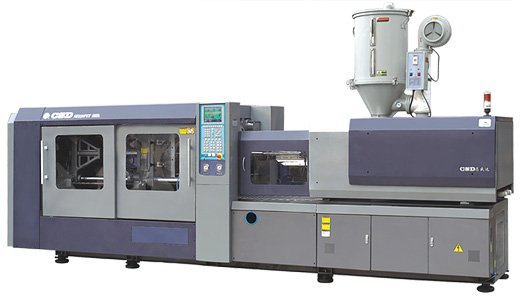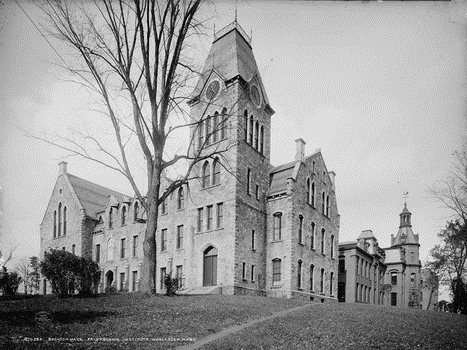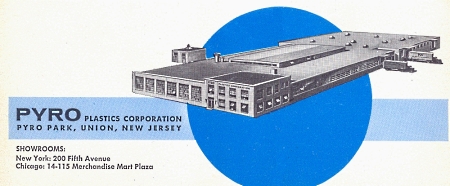Return to kits for sale
By Alan Bussie Google+ profile
Second Edition Notes
In the first edition, credit was given to one man for the first modern injection molding machine. This may or may not be true; evidence gathered over the last 3 years paints a more complicated picture. This revision is not an effort to take credit away from anyone but to give it where due.
I would like to thank artist and friend Michael Boss, Peter van Lune, Marsha Frantisak and the “Industry Watch” article cited below. Without these sources this article would not be possible. Marsha is niece of William Lester and granddaughter of Nathan Lester. Please note that any photos without credits are from the internet. If you did not receive credit or if any of these photos are copyrighted, please contact me for credit or removal. Thank you-AB
Introduction
Pyro is not the most famous of the US plastic model companies. Die-hard collectors know the name well, but even fewer are aware that Pyro’s founder, William Lester, was an entrepreneur, innovator and inventor. Furthermore, William learned molding from his father, Nathan Lester. Both of these men had a hand in inventing the modern plastic injection molding machine, which completely revolutionized American plastics manufacturing. Some details are lost to history but enough is known to create a rough portrait.

Modern Injection Molding Machine (courtesy Western Kentucky Plastics)
Biography
William’s father, Nathan Lester, was born in 1884 in Minsk, Russia and immigrated in 1905. Bill’s mother, Mrs. Gussie Lester, was also born in Russia in 1884. We do not know much else about his youth, but Nathan was a brilliant man and entrepreneur who reached the top of his industry. He owned Lester Die & Machine Company of Cleveland (1920s to ?, referred to as ‘Lester Tool’ later), Lester-Phoenix Die Casting Machines in Cleveland (30s/40s+), one of the leading die-cast companies in the USA. At least one trade catalog (dated 1941) of Lester-Phoenix Die has survived. He also owned Lester Engineering and held numerous patents. This is a small sample:
- Pneumatic die-casting machine filed as early as 1926
- Plastic Casting Machine filed April 15, 1938 and granted June 3, 1941 by the Patent Office
- Link mechanism for pressure casting machines filed as early as 1939
- Injection molding control apparatus filed in 1943
- Injection molding machine spreader filed in 1944
In the book “The Story of New Jersey(1945),” Nathan is credited as being one of the “leading die casters in the United States” and heading a company (identified later as Lester-Phoenix) which “…builds die casting machines and different types of plastic moulding machines.” Paul Orban, the second engineer hired by Lester Engineering (and later chief engineer) said that “He was a pleasant man to work with, a chain smoker, and he paced like a lion in a cage in the engineering department. He was cordial and honest. Nathan was originally a tool-and-die maker. He worked for Reed before starting his own company.”
Nathan’s son, William Morris Lester, was born in Brooklyn, New York on Jan. 14, 1908. He attended Brooklyn public schools and graduated high school in Worchester, MA in 1904. His father’s business impacted him early; William was still in school when he started designing molds and casting machines. After high school he enrolled in Worcester Polytechnic Institute. He graduated in 1928 with a BS in Mechanical Engineering and extensive background experience in die casting machines and mold design.

Worcester Polytechnic Institute
His first job was Developmental Engineer for Precision Castings Co., Syracuse, NY. After almost three years, his entrepreneurial spirit prompted him to leave in 1930/31. Bill went to his father’s shop, Lester Tool and Die Company, and Bill’s first job was Chief Engineer. Bill did own stock in Lester Tool, but it is unknown if he bought the stock before or after he became an employee. Bill designed molds and die casting machines for Lester, and Reed-Prentice Company manufactured the machines under license. Bill increased the efficiency of mold making through numerous improvements and attachments for tool- room equipment. He received several patents for these innovations in pressure and die casting equipment. Given the early dates (from the 1920) of Nathan’s patents and his leadership in the field, his son certainly learned the practical engineering and the business sides from his father. Bill worked about four years at Lester Tool. As we will see, he was a very fast study.
Continue reading “Nathan Lester & William (Bill) Morris Lester – The Origins Of Modern Injection Molding And Pyro Plastics Company”



